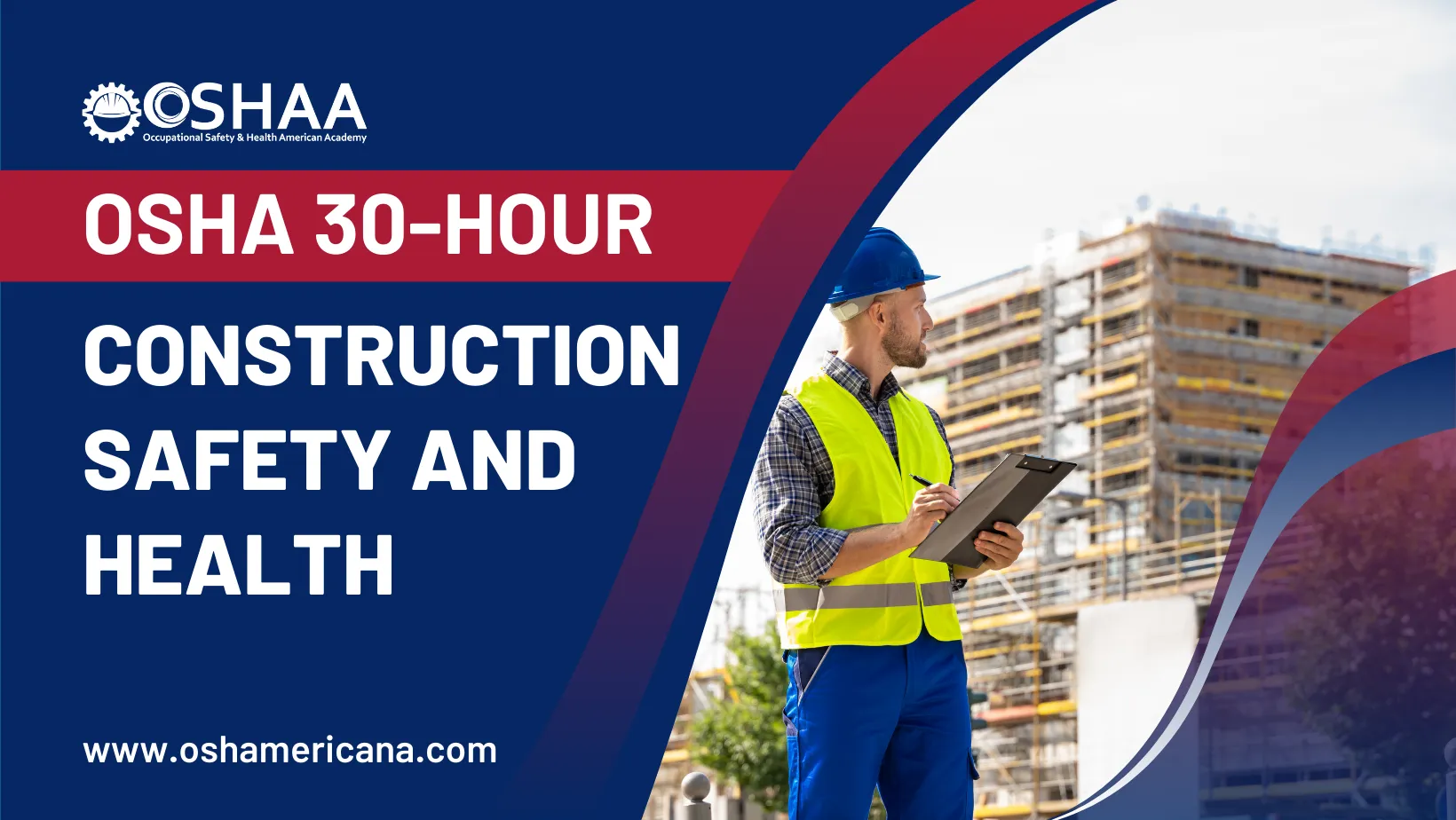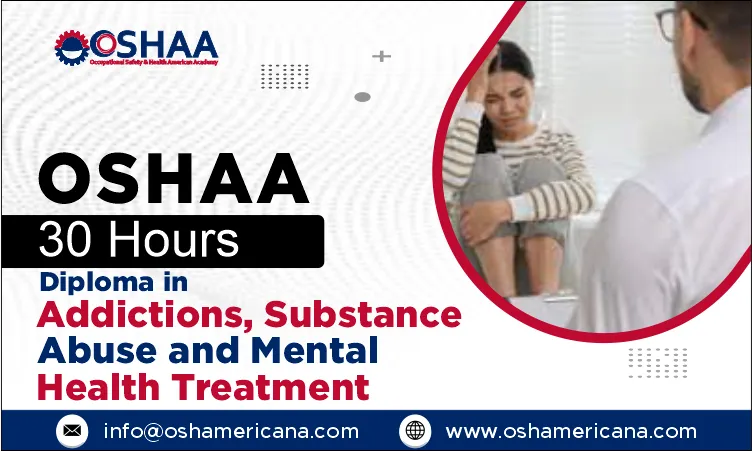In the dynamic and challenging environment of construction sites, safety isn’t just a priority – it’s a fundamental requirement. The Occupational Safety and Health Administration (OSHA) recognizes this need and has developed the OSHA 30-Hour Construction Safety and Health course to equip workers and supervisors with comprehensive safety training.
This course plays a crucial role in ensuring that construction professionals can identify hazards, implement safety measures, and adhere to regulatory standards, ultimately fostering safer work environments across the industry.
The OSHA 30-Hour Construction Safety and Health course is an intensive training program designed to educate participants about safety practices specific to the construction industry. Whether you’re a seasoned construction worker, a supervisor, or new to the field, this course provides essential knowledge and skills to enhance safety awareness, mitigate risks, and promote a culture of safety on construction sites.
The OSHA 30-Hour Construction Safety and Health course is not just a requirement; it’s a critical investment in the safety and well-being of everyone on construction sites. By completing this course, construction professionals can play a pivotal role in creating safer work environments, protecting lives, and ensuring compliance with regulatory standards.
Whether you’re looking to enhance your skills, advance your career, or simply prioritize safety, the OSHA 30-Hour Construction Safety and Health course equips you with the knowledge and tools to succeed in the challenging and rewarding field of construction.
OSHA 30-Hour Construction Safety and Health
To enroll in the OSHA 30-Hour Construction Safety and Health Course, learners are expected to meet the following criteria:
Study Units
Learning Outcomes
1. Introduction to OSHA
- Understanding OSHA’s Role: Recognize OSHA’s mission and responsibilities in promoting workplace safety.
- Worker Rights: Understand workers’ rights under OSHA regulations, including the right to a safe workplace.
- Employer Responsibilities: Identify employer responsibilities for providing a safe and healthful workplace environment.
- OSHA Standards: Familiarize with key OSHA standards applicable to the construction industry.
2. Managing Safety and Health
- Safety Management Systems: Implement and manage safety programs to ensure compliance and foster a culture of safety.
- Risk Assessment: Conduct hazard assessments and develop control measures to mitigate workplace hazards.
- Training Programs: Establish and oversee safety training programs for employees on construction sites.
- Compliance: Ensure compliance with OSHA regulations and industry standards through effective safety management.
3. Focus Four Hazards
- Fall Hazards: Identify and address fall hazards in construction, including falls from heights and scaffold falls.
- Electrical Hazards: Recognize electrical hazards and implement safe work practices to prevent electrical accidents.
- Struck-by Hazards: Implement measures to prevent injuries from being struck by objects, such as falling materials or equipment.
- Caught-in or Between Hazards: Identify and mitigate hazards associated with caught-in or between incidents, such as trench collapses or machinery accidents.
4. Personal Protective Equipment (PPE)
- Selection and Use: Select appropriate PPE for construction hazards, including head protection, eye protection, and respiratory protection.
- Training: Provide training on the proper use, maintenance, and limitations of PPE to protect against workplace hazards.
- Fit Testing: Conduct fit testing and ensure proper fit of PPE to effectively protect workers from construction-related hazards.
- Compliance: Comply with OSHA requirements for PPE, including recordkeeping, hazard assessment, and training documentation.
5. Health Hazards in Construction
- Chemical Hazards: Identify chemical hazards in construction, such as silica dust, asbestos, and lead exposure.
- Biological Hazards: Recognize biological hazards, including mold, bacteria, and viruses, and implement control measures.
- Physical Hazards: Address physical hazards such as noise, vibration, and extreme temperatures to protect worker health.
- Health Monitoring: Implement health monitoring programs to monitor and mitigate construction-related health risks.
6. Cranes and Rigging
- Safe Operation: Operate cranes and rigging equipment safely to prevent accidents and injuries on construction sites.
- Inspections: Perform regular inspections of cranes and rigging equipment to ensure safe operation and compliance with standards.
- Load Handling: Safely handle and secure loads using cranes and rigging equipment to prevent incidents and damage.
- Training: Provide training on crane and rigging safety, including equipment operation, maintenance, and load handling practices.
7. Stairways and Ladders
- Safe Use: Use stairways and ladders safely on construction sites to prevent falls and injuries.
- Inspection: Inspect stairways and ladders regularly for defects and hazards, and take corrective actions as needed.
- Setup and Placement: Properly set up and place stairways and ladders to ensure stability and prevent slips and falls.
- Training: Provide training on stairway and ladder safety, including proper use, maintenance, and hazard recognition.
8. Confined Spaces
- Identification: Identify confined spaces on construction sites and assess associated hazards, such as atmospheric, mechanical, and engulfment risks.
- Entry Procedures: Implement safe entry procedures for confined spaces, including permit-required confined space protocols.
- Monitoring: Continuously monitor atmospheric conditions within confined spaces to ensure worker safety.
- Rescue Planning: Develop and implement confined space rescue plans and procedures to respond to emergencies effectively.
9. Excavations
- Trenching Hazards: Identify and assess trenching hazards, including cave-ins, hazardous atmospheres, and falling objects.
- Protective Systems: Implement protective systems, such as shoring, sloping, and trench boxes, to prevent trenching accidents.
- Inspections: Conduct daily inspections of excavations and protective systems to ensure compliance and worker safety.
- Training: Provide training on excavation safety, including soil classification, trenching methods, and protective system requirements.
10. Scaffolds
- Assembly and Disassembly: Safely assemble, use, and dismantle scaffolds according to manufacturer instructions and OSHA standards.
- Fall Protection: Implement fall protection measures, such as guardrails, personal fall arrest systems, and safety nets, on scaffolds.
- Inspections: Conduct scaffold inspections before each use and after any alterations to ensure structural integrity and safety.
- Training: Provide training on scaffold safety, including erection, use, inspection, and fall protection requirements.
11. Fire Protection and Prevention
- Fire Hazards: Identify fire hazards on construction sites, such as flammable materials, ignition sources, and hot work operations.
- Prevention Measures: Implement fire prevention measures, including housekeeping, proper storage of flammable materials, and fire watch procedures.
- Emergency Response: Develop and practice fire emergency response plans, including evacuation procedures and use of fire extinguishing equipment.
- Training: Provide training on fire hazards, prevention measures, emergency response procedures, and safe use of fire extinguishers.
12. Electrical Safety
- Electrical Hazards: Recognize electrical hazards on construction sites, such as exposed wires, damaged equipment, and overhead power lines.
- Safe Work Practices: Implement safe work practices when working with or near electrical systems and equipment to prevent electrocution.
- Lockout/Tagout: Follow lockout/tagout procedures to de-energize and isolate electrical systems and equipment for maintenance and repair.
- Training: Provide training on electrical safety, including hazard recognition, safe work practices, and emergency procedures.
13. Materials Handling, Storage, Use, and Disposal
- Safe Handling: Handle materials safely on construction sites to prevent injuries and property damage.
- Storage Practices: Store materials securely to prevent hazards such as falls, collapses, and spills.
- Use Procedures: Implement safe procedures for using materials and equipment, including proper lifting techniques and equipment operation.
- Disposal: Dispose of waste materials properly and in accordance with environmental regulations to prevent pollution and hazards.
14. Hand and Power Tools
- Safe Use: Use hand and power tools safely on construction sites, following manufacturer instructions and OSHA standards.
- Maintenance: Maintain tools regularly to ensure proper functioning and safety.
- Guarding: Use tools with appropriate guards and safety features to prevent injuries.
- Training: Provide training on hand and power tool safety, including selection, inspection, use, and maintenance.
15. Welding and Cutting
- Safety Precautions: Implement safety precautions during welding and cutting operations to prevent fires, explosions, and exposure hazards.
- Ventilation: Ensure adequate ventilation to control fumes and gases generated during welding and cutting processes.
- Personal Protective Equipment: Wear appropriate PPE, such as welding helmets, gloves, and clothing, to protect against welding and cutting hazards.
- Training: Provide training on welding and cutting safety, including equipment setup, operation, and hazard recognition.
16. Motor Vehicles, Mechanized Equipment, and Marine Operations
- Operation Safety: Operate motor vehicles, mechanized equipment, and marine vessels safely on construction sites and waterways.
- Traffic Control: Implement traffic control measures to protect workers and prevent accidents involving vehicles and equipment.
- Maintenance: Perform regular maintenance and inspections of vehicles, equipment, and vessels to ensure safe operation.
- Training: Provide training on vehicle and equipment operation, traffic control, and marine operations safety.
17. Ergonomics
- Risk Factors: Identify ergonomic risk factors in construction tasks, such as lifting, repetitive motions, and awkward postures.
- Preventive Measures: Implement ergonomic controls and adjustments to reduce the risk of musculoskeletal disorders (MSDs) and injuries.
- Training: Provide training on ergonomic principles, safe work practices, and workstation setup to promote worker comfort and productivity.
- Feedback: Encourage worker feedback and participation in ergonomic assessments and improvement initiatives.
18. Concrete and Masonry Construction
- Hazards: Identify hazards associated with concrete and masonry construction, such as falls, struck-by incidents, and silica exposure.
- Safe Practices: Implement safe practices for handling, pouring, and finishing concrete and masonry materials to prevent injuries.
- Formwork and Shoring: Ensure proper installation and bracing of formwork and shoring systems to prevent collapses and structural failures.
- Training: Provide training on concrete and masonry construction safety, including hazard recognition, equipment operation, and personal protective measures.
19. Steel Erection
- Safety Precautions: Implement safety precautions during steel erection activities to prevent falls, structural collapses, and struck-by incidents.
- Fall Protection: Use appropriate fall protection systems, such as guardrails, safety nets, and personal fall arrest systems, during steel erection work.
- Lifting Operations: Safely lift, position, and secure steel components using cranes and rigging equipment to prevent accidents and injuries.
- Training: Provide training on steel erection safety, including hazard awareness, equipment operation, and compliance with OSHA standards.
20. Safety and Health Programs
- Program Development: Develop and implement comprehensive safety and health programs tailored for construction sites to promote a culture of safety.
- Employee Involvement: Engage employees in safety programs, including hazard reporting, safety meetings, and safety committees.
- Evaluation: Evaluate safety and health program effectiveness through inspections, audits, and feedback mechanisms.
- Continuous Improvement: Identify areas for improvement and implement corrective actions to enhance safety performance and reduce incidents.
These learning outcomes are aligned with OSHA standards and provide construction workers and supervisors with the knowledge and skills necessary to promote a safe and healthful work environment on construction sites.
- Enhanced Safety Awareness:
- Knowledge of Hazards: Gain a comprehensive understanding of construction-related hazards, including falls, electrical hazards, and hazardous materials.
- Risk Assessment Skills: Develop skills to identify, assess, and control workplace hazards, enhancing safety awareness among workers and supervisors.
- Reduced Incidents and Injuries:
- Preventative Measures: Implement proactive safety measures and protocols to prevent workplace accidents, injuries, and fatalities.
- Emergency Preparedness: Equip workers with the knowledge and skills to respond effectively to emergencies, such as fires and medical incidents.
- Legal Compliance:
- OSHA Standards: Ensure compliance with OSHA regulations and industry standards specific to the construction industry.
- Avoid Penalties: Reduce the risk of fines, penalties, and legal liabilities associated with non-compliance with safety regulations.
- Improved Workplace Culture:
- Safety Commitment: Foster a culture of safety where workers and supervisors prioritize safety in all aspects of construction activities.
- Team Collaboration: Encourage teamwork and communication regarding safety practices, leading to a safer and more cohesive work environment.
- Professional Development:
- Career Advancement: Enhance career prospects and opportunities for advancement within the construction industry by demonstrating a commitment to safety.
- Credentials: Earn a recognized certification that validates your knowledge and competence in construction safety and health.
- Cost Savings:
- Insurance Premiums: Potentially lower insurance premiums by demonstrating proactive risk management and safety practices.
- Productivity: Minimize downtime due to accidents and injuries, thereby maintaining productivity and project timelines.
- Health Protection:
- Personal Protective Equipment (PPE): Ensure proper selection, use, and maintenance of PPE to protect workers from occupational hazards.
- Health Hazards: Address health hazards such as exposure to silica dust, asbestos, and other harmful substances through proper training and controls.
- Industry Reputation:
- Client Confidence: Build trust and confidence with clients, subcontractors, and stakeholders by prioritizing safety and health on construction projects.
- Competitive Edge: Differentiate your company in the marketplace by showcasing a commitment to safety and compliance with industry best practices.
The OSHA 30-Hour Construction Safety and Health course is not only a regulatory requirement but also a strategic investment in the safety, well-being, and success of construction professionals and their organizations. By completing this comprehensive training program, individuals and companies can reap the benefits of a safer work environment, legal compliance, enhanced professionalism, and improved overall project outcomes. Investing in construction safety training is a proactive step towards ensuring a sustainable and thriving construction industry where safety is paramount.
The target audience for the OSHA 30-Hour Construction Safety and Health course includes:
- Construction Workers:
- General Laborers: Engaged in various construction activities such as excavation, demolition, and material handling.
- Tradespeople: Including carpenters, electricians, plumbers, and HVAC technicians working on construction sites.
- Equipment Operators: Operating heavy machinery and vehicles like cranes, forklifts, and excavators.
- Welders and Fabricators: Involved in steel erection, welding, and cutting activities on construction projects.
- Construction Supervisors and Foremen:
- Site Supervisors: Responsible for overseeing day-to-day operations and ensuring compliance with safety regulations.
- Foremen: Leading teams and coordinating activities to maintain a safe and efficient work environment.
- Safety Officers and Managers:
- Safety Coordinators: Focused on implementing safety programs, conducting inspections, and training personnel.
- Safety Managers: Overseeing safety protocols, incident investigations, and compliance with OSHA standards on construction sites.
- Project Managers and Engineers:
- Project Managers: Responsible for overall project planning, scheduling, and ensuring safety throughout project execution.
- Engineers: Involved in design, planning, and implementation of safety measures and protocols specific to construction activities.
- Contractors and Subcontractors:
- Construction Contractors: Managing subcontractors and ensuring that all workers on-site adhere to safety standards.
- Subcontractors: Engaged in specialized construction tasks such as roofing, concrete pouring, and electrical installations.
- Safety Consultants and Trainers:
- Safety Consultants: Providing expertise in developing and implementing safety programs and procedures for construction firms.
- Safety Trainers: Conducting OSHA-certified training programs to educate construction personnel on safety practices and regulations.
- Construction Industry Professionals:
- Owners and Developers: Overseeing construction projects and ensuring compliance with safety requirements to protect investments and maintain project timelines.
- Industry Associations and Organizations: Supporting the development and dissemination of safety standards and best practices within the construction sector.
The OSHA 30-Hour Construction Safety and Health course is essential for anyone involved in construction activities, from workers and supervisors to managers and consultants. It equips participants with the knowledge and skills needed to mitigate risks, enhance safety practices, and comply with regulatory standards, thereby contributing to a safer and more productive construction environment.







